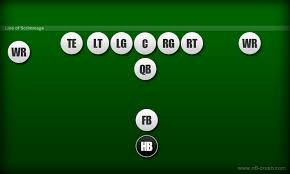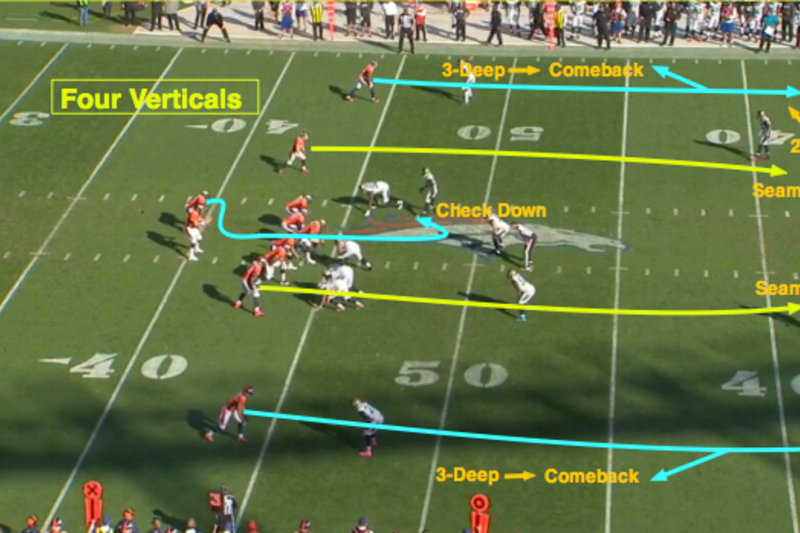Hb in football stands for Halfback. It’s a crucial position in American football.
The halfback is often the team’s primary ball carrier. In football, every player has a unique role. The halfback, or Hb, is key in both offense and defense. This position requires speed, agility, and strong decision-making skills. The halfback’s main job is to run with the ball.
But that’s not all. They also block for the quarterback and catch passes. Understanding the role of a halfback can change how you watch the game. It adds depth to your football knowledge. Let’s dive deeper into the duties, skills, and importance of the halfback position in football.
Introduction To Hb In Football
Football, a globally cherished sport, has many roles and positions. Each role has its unique importance and responsibilities. One such role that often stands out is the Halfback, abbreviated as Hb.
The Halfback plays a pivotal role in both offense and defense. Understanding the role of a Halfback can enhance your appreciation of football. It can also help you enjoy the game more.
History Of Hb
The Halfback position has evolved over the years. Initially, it was a defensive role. Players had to stop the opposition’s attack.
With time, the Halfback became crucial in offensive plays too. This dual role made the position versatile and essential. Today, the Halfback is a key player on the field.
Importance Of Hb
The Halfback has a significant impact on the game’s outcome. They often carry the ball and make crucial plays. Their ability to switch between defense and offense is vital.
A good Halfback can change the game’s pace. They can break through defensive lines or stop a fast attack. This makes them indispensable to their team.
In essence, the Halfback’s role is central to a team’s strategy. Their performance can lead to victory or defeat.

Credit: www.nfl-crush.com
Roles And Responsibilities
The Halfback, or Hb, is a key position in football. Understanding their roles and responsibilities is crucial for appreciating the game. The Halfback’s functions can define the team’s success on the field. They play an essential role in both offense and defense. Let’s explore their core duties and on-field impact.
Core Duties
The Halfback has several important responsibilities. They often carry the ball on running plays. This requires speed, agility, and vision. The Halfback must also block defenders to protect the quarterback. This blocking is crucial during passing plays. They must read the defense quickly and adjust their position. Another duty is catching passes from the quarterback. This adds a layer of versatility to the team’s offense. The Halfback’s role demands a mix of strength and intelligence.
On-field Impact
The Halfback’s actions can change the game’s momentum. A successful run can gain significant yards. This helps the team move closer to scoring. Blocking by the Halfback provides the quarterback with more time. This time is vital for making accurate passes. Catching passes keeps the defense guessing. It adds unpredictability to the offense. The Halfback also contributes to special teams. They may play a role in kick returns. Their versatility and impact are evident in every game. The Halfback’s performance can influence the overall team strategy.
Skills Required
Understanding the position of a Halfback (Hb) in football requires knowledge of the various skills needed. This role demands proficiency in multiple areas to contribute effectively to the team. Let’s break down the essential skills under two main categories.
Technical Skills
A Halfback must have strong ball-handling abilities. They need to be able to control and maneuver the ball accurately. Passing is another critical skill. Quick and precise passes can make a significant difference during the game.
- Ball Control
- Passing Accuracy
- Tackling
- Vision
- Dribbling
Tackling is also essential for a Halfback. They need to win the ball back from the opposition. Vision allows them to anticipate the moves of opponents and teammates. Good dribbling skills help in maintaining possession and advancing the ball.
Physical Attributes
Physical fitness is non-negotiable for a Halfback. They must have excellent endurance to maintain performance throughout the game. Speed is crucial for both offensive and defensive plays. Strength is needed to withstand physical challenges from opponents.
| Attribute | Importance |
|---|---|
| Endurance | High |
| Speed | High |
| Strength | Medium |
| Agility | Medium |
Agility is also important for quick changes in direction. A Halfback should be able to respond swiftly to different game situations. This combination of skills and attributes makes a Halfback a vital player on the field.
Training And Development
Training and development in football are essential for players to reach their full potential. This is especially true for Halfbacks (Hb). They need specific routines to enhance their performance on the field. Below, we delve into the key areas of their training and development.
Training Regimens
Halfbacks require varied and intensive training regimens. These routines are designed to build strength, agility, and endurance. A typical weekly schedule might include:
- Strength training: Focus on core and lower body.
- Cardio sessions: Improve stamina and endurance.
- Agility drills: Enhance quick footwork and direction changes.
- Practice games: Simulate real match conditions.
Coaches often use a mix of these activities to keep the training dynamic. This helps keep the players engaged and motivated.
Skill Enhancement
Skill enhancement is crucial for a halfback’s development. They must master various techniques to excel in their role. These skills include:
- Ball control: Practice dribbling and maintaining possession.
- Passing accuracy: Work on short and long passes.
- Shooting technique: Improve precision and power.
- Defensive skills: Develop tackling and interception abilities.
Training sessions often focus on specific skills each day. This targeted approach ensures players develop a well-rounded skill set.
Coaches might also use video analysis to help players see areas for improvement. This visual aid can be very effective in correcting mistakes and refining techniques.
Tactical Importance
The Halfback (Hb) in football plays a crucial tactical role. This position bridges the defense and the midfield. It requires unique skills and awareness. The Hb can greatly influence the game’s outcome by their positioning and strategies.
Positioning
Positioning is vital for the Halfback. They need to be in the right spot at all times. This helps the team maintain balance. The Hb must understand the game’s flow. They predict where the ball will go next. Good positioning allows them to intercept passes. It also helps them support both defense and attack.
Game Strategies
Game strategies often revolve around the Halfback. Coaches design plays that maximize the Hb’s strengths. They may use the Hb to control the game’s pace. The Hb can switch from defense to attack quickly. This keeps the opponent guessing. The Hb’s decisions on the field are crucial. They can dictate the team’s overall performance.

Credit: www.football-tutorials.com
Famous Hb Players
Football has seen many great half-backs (Hb) throughout its history. These players have left a mark on the game with their unique skills. Their ability to control the midfield is legendary. Let’s explore some of the most famous Hb players in football history.
Legendary Players
First, there’s Franz Beckenbauer. Known as “The Kaiser,” he was a master in the 1970s. His ability to read the game was unmatched. Beckenbauer’s leadership on the field made him a true legend.
Another iconic player is Johan Cruyff. He was a playmaker who changed the way the game was played. Cruyff’s vision and technique were extraordinary. He made a big impact in both Ajax and Barcelona.
Then, there’s Bobby Moore. The English defender is remembered for his clean tackles and calm presence. Moore led England to their World Cup win in 1966. His skill as a half-back was second to none.
Modern Stars
Today, Sergio Busquets stands out as a top half-back. His ability to break up attacks and start plays is crucial for Barcelona. Busquets’ football IQ is one of the best in the game.
N’Golo Kanté is another name that shines. Known for his endless energy, Kanté covers every inch of the field. His role in Leicester City’s Premier League win was vital. Kanté’s work ethic is admired by many.
Lastly, Luka Modrić deserves mention. The Croatian star has been key for Real Madrid. His passing and vision are exceptional. Modrić’s performances in big games have earned him many accolades.
Challenges Faced
Playing as a halfback (HB) in football comes with many challenges. These challenges test a player’s physical and mental strength. Understanding these challenges can help players prepare better.
Injury Risks
Halfbacks often face injury risks. The position requires quick movements and sudden changes in direction. This increases the chance of strains and sprains. Contact with other players can lead to more serious injuries. Staying fit and following a good training routine can reduce these risks.
Performance Pressure
Performance pressure is another challenge for halfbacks. They play a key role in both offense and defense. Coaches and teammates rely on them to perform well. Fans also have high expectations. This can create stress and anxiety. Managing this pressure is crucial for success. Practicing relaxation techniques can help.

Credit: en.wikipedia.org
Future Of Hb In Football
The role of the halfback (Hb) in football has evolved over time. As the game advances, the future of this position promises more changes. Let’s explore some key areas that will shape the future of the Hb in football.
Evolving Roles
The halfback’s role is becoming more versatile. Traditionally, Hbs were known for their running skills. Today, they are expected to excel in multiple areas. A modern Hb must have good catching abilities, blocking skills, and tactical awareness.
Teams now use Hbs in various formations. This is to exploit their diverse skills. A well-rounded Hb can be a game-changer in different scenarios. This shift requires Hbs to undergo more specialized training.
Technological Advancements
Technology is transforming football. Advanced analytics and wearable tech provide detailed insights. This helps Hbs to improve their performance. Coaches use data to identify strengths and weaknesses. This leads to more efficient training programs.
Virtual reality (VR) is another tool enhancing Hb training. VR allows players to practice in simulated environments. This helps them understand different game situations better. It also reduces the risk of physical injuries during practice.
Here is a summary of the technological advancements impacting Hbs:
| Technology | Impact |
|---|---|
| Advanced Analytics | Improves performance tracking |
| Wearable Tech | Provides real-time data |
| Virtual Reality | Enhances tactical understanding |
All these advancements aim to make the Hb position more dynamic. The future of the Hb in football looks promising with these changes.
Frequently Asked Questions
What Is Hb In Football?
In football, Hb stands for Halfback. The halfback is a versatile position, often responsible for both running and receiving.
What Does A Halfback Do In Football?
A halfback in football runs the ball, blocks, and catches passes. They are key in offensive plays.
Is Halfback The Same As Running Back?
Yes, the halfback is a type of running back. They often share similar responsibilities and roles on the field.
Why Is The Halfback Important?
The halfback is crucial for offensive strategy. They can run, block, and catch, making them versatile players.
Conclusion
Understanding Hb in football is crucial for any fan. It stands for halfback, a key player. The halfback runs, blocks, and sometimes catches passes. They are versatile and vital. Knowing their role enhances game enjoyment. Next time you watch, you’ll appreciate their impact.
Keep learning about football positions. It enriches your experience. Enjoy the game!





